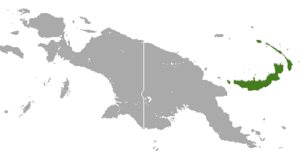Black-bellied fruit bat facts for kids
Quick facts for kids Black-bellied fruit bat |
|
|---|---|
 |
|
| Conservation status | |
| Scientific classification | |
| Genus: |
Melonycteris
|
| Species: |
melanops
|
 |
|
| Black-bellied fruit bat range | |
The black-bellied fruit bat (Melonycteris melanops) is a special type of bat. It belongs to a family called Pteropodidae, which are also known as megabats or fruit bats. These bats are known for their unique fur colors and interesting habits.
Contents
Where They Live and What They Eat
Black-bellied fruit bats are only found in the Bismarck Archipelago. This is a group of tropical islands in Papua New Guinea. They can live anywhere from sea level up to high mountains, about 1,600 meters (or 5,250 feet) high.
These bats are quite special because they do well even when humans change their habitat. Many of them now live and find food in banana trees. They also live in traditional gardens and cocoa farms owned by people.
What do they eat? They love to munch on fruit and drink nectar. Their favorite foods include giant native bananas and cocoa. They have long tongues that they pump quickly into flowers to slurp up the sweet nectar.
What They Look Like
Black-bellied fruit bats are not very big. They usually weigh about 63 grams (which is about the same as a tennis ball). They are around 94 millimeters (about 3.7 inches) long. Their front limbs, which are like their arms, measure about 60 millimeters (about 2.4 inches).
One of the coolest things about them is their fur! They have a unique color pattern. Their bellies are black, and their backs are a burnt orange color. This helps them blend in with their surroundings.
How They Behave
Both male and female black-bellied fruit bats are very protective of their space. They strictly control their own "home range." This means they have a special area where they live and find food. The only time their home ranges might overlap is if they are a male and female pair. Bats of the same gender are never allowed to enter another bat's home range.
These bats are smart about how they find food. They spend less than 36% of their time flying when they are actively looking for food. This is because they eat right where they find the food instead of carrying it back to their resting spot. This saves them a lot of flying time compared to other fruit bats. When they do fly, each flight usually lasts about 20 to 30 seconds. They can make up to 99 short flights in just two hours!
During the day, these bats like to rest among dry banana leaves. Their burnt orange and black fur helps them hide perfectly. They usually roost alone, staying close to their favorite feeding spots. Young bats, called sub-adults, might roost further away. This is because they haven't found their own territory yet. They have to wait for a space to open up or fight to claim one.
Their Body and How It Works
Black-bellied fruit bats are warm-blooded, meaning their bodies make their own heat. However, they aren't very good at keeping their body temperature steady. The temperature around them affects their body temperature.
They are most comfortable when the temperature is between 28 and 33 degrees Celsius (about 82 to 91 degrees Fahrenheit). If the temperature drops below 28 degrees Celsius, their body temperature goes down a bit. They also use more oxygen to try and stay warm.
Sometimes, if it gets really cold (below 20 degrees Celsius or 68 degrees Fahrenheit), a small number of these bats might enter a state called "torpor." This is like a short, light sleep where their body slows down to save energy.
Bat Family Tree
The black-bellied fruit bat is closely related to another bat called Fardoulis's blossom bat. After that, it's related to the long-tongued nectar bat and the common blossom bat. Scientists have found that the black-bellied fruit bat is a very old type of megabat. It's like a "primitive" form of the Pteropodidae family.


